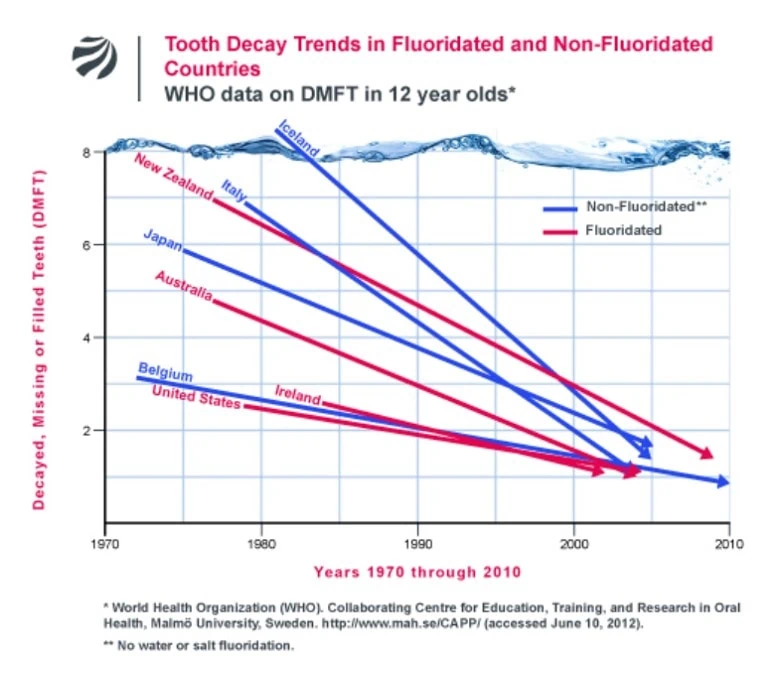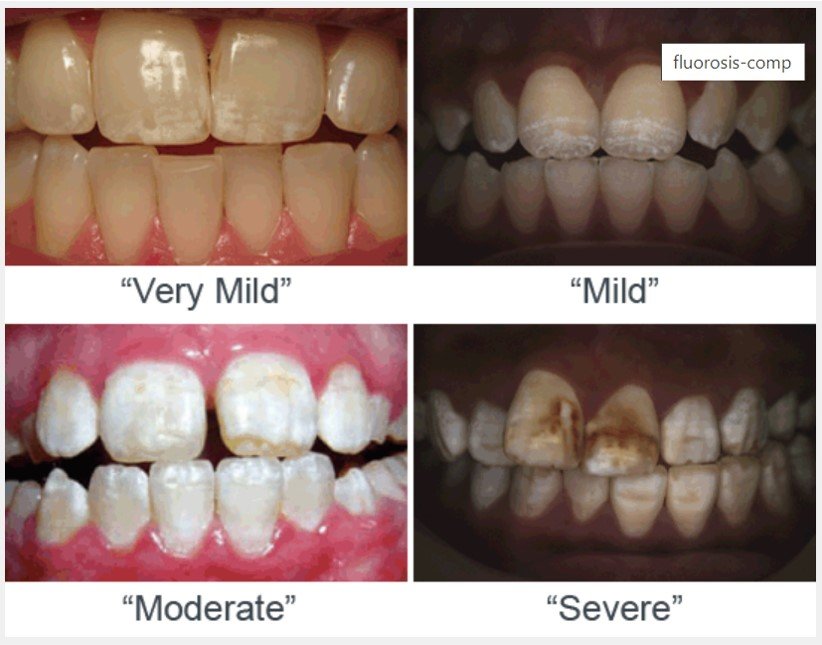Water Fluoridation Part 1: Understanding the Fluoride Controversy

Water fluoridation is under the spotlight in New Zealand as the decision to add fluoride to public drinking supplies has become the sole responsibility of the Director-General of Health, removing the decision from local communities who have been voting NO. In the light of a damning review from a US government agency proving that fluoride is as harmful as lead to children’s brains, we explore the topic of water fluoridation from a historical, individual health, political and population health perspectives in this two-part article series (Water Fluoridation Part 2: Dirty Politics and the Implications for Population Health).
What is Fluoride?
A range of compounds containing the gaseous chemical element fluorine (F) are collectively known as fluoride. A naturally occurring compound is calcium fluoride (CaF), found in soil and water in varying amounts depending on location.
The compounds used for water fluoridation are effluent from industrial processes. Hydrofluorosilicic acid is the cheapest and most commonly used compound; sodium silicofluoride may still be used in some locations.
Other fluorides, including the chemicals added to water supposedly for dental health, are by-products of industrial manufacturing. High concentrations of fluoride are found in raw phosphate, which is manufactured into fertiliser. The manufacturing process results in gaseous effluent consisting of two highly toxic fluoride compounds (hydrogen fluoride and silicon tetrafluoride).
Without adequate pollution control these gases can cause horticultural and agricultural destruction, and human health harms, to surrounding communities. Due to this toxicity they are banned from being released into the environment. Following good manufacturing practices, product recovery units known as “scrubbers” capture the gases and condense them into fluorosilicic acid. Until the 1940s this fluoride compound was considered to be toxic industrial waste.
Fluoride, Teeth and the Atomic Bomb is a heavily-censored 1997 article authored by medical writers Chris Bryson and Joel Griffiths, who obtained declassified World War II documents showing that fluoride was the key chemical in atomic bomb production. They revealed fluoride as the foremost chemical health hazard for both atomic bomb program staff and nearby communities.
Christopher Bryson’s book The Fluoride Deception covers the story in detail. His 2004 interview with Dr. Paul Connett of the Fluoride Action Network is a worthwhile half hour.

Learn more about fluoride as a neurotoxin which reduces childhood IQ from presentations given at Otago University in 2018 by international experts, Professor Paul Connett (environmental chemist and toxicologist), Declan Waugh (environmental scientist) and Vyvyan Howard (pathologist).
History of Water Fluoridation
Fluoride poisoning was the earliest focus of lawsuits against the atomic bomb program. In response, authorities designed, implemented and analysed extensive research into the effects of fluoridating public drinking water. Using the frequently occurring theme of ‘national security’ as an excuse, adverse outcomes were heavily censored, as were the US government’s conflicts of interest in needing to prove that fluoride was safe to human health.
Whilst the decade-long trials concluded that dental caries in communities with fluoridated water reduced between 50%-70%, data was not made available from those communities without fluoridated water, thus obscuring the real results. Evidence shows that dental health improvements are in fact due to other factors such as improved diet, more tooth brushing and access to improved medical interventions such as antibiotics.
Since that time, human exposure to fluoride has snowballed via water fluoridation, toothpaste and other dental products, as well as pesticide residues and medications containing fluoride.
As we have learned through the myriad covid-related violations, regulatory agencies such as the Environmental Protection Agency and their various international counterparts, are captured by the industries they purport to regulate, ensuring corporate profits prevail over health protection. New Zealand’s own Prime Minister’s Chief Science Advisor (PMCSA) appears to be similarly captured.
Health Implications of Water Fluoridation
There are a range of resources available including Fluoride Free New Zealand. Their parent organisation, Fluoride Action Network, develops and maintains a comprehensive online database of information about fluoride from official sources, academic literature, correspondence and news reports. Whilst many claims are made that because CaF is a naturally-occurring mineral, fluoride exposure is somehow safe or even necessary, it is in fact comparable to naturally occurring elements such as lead or arsenic.
Prevention of Dental Caries
Although rates of tooth decay have in fact precipitously declined across western nations in the past fifty years despite most western nations not fluoridating their water, a wealth of research appears to confirm that water fluoridation reduces decayed, missing and filled teeth (DMFT) in populations. Most research supporting water fluoridation to prevent dental caries appears to ignore the World Health Organization data showing no difference in DMFT rates at 12 years old between places with and without water fluoridation.

Dental Fluorosis
Dental fluorosis is the name given to damaged tooth enamel caused by over-exposure to fluoride in early childhood, to eight years of age. Fluorosis is a manifestation of prolonged exposure to higher concentrations of fluoride, which bioaccumulates in the bones (meaning concentration levels increase with each exposure). The enamel becomes increasingly porous as it loses the minerals needed to retain integrity of the tooth. The teeth can become brittle and the stained look can be disfiguring.

Causes include drinking fluoridated water and consuming products made with fluoridated water (including artificial infant milk formula and processed foods), fluoride-containing toothpaste, dental products and supplements. Simultaneous to the reduction in decayed, missing and filled teeth, cases of dental fluorosis have risen.
An oral health survey conducted by the NZ Ministry of Health in 2009 found that almost 50% of our children have some form of dental fluorosis. As there have been no further studies since then, the current rates remain unknown.
Skeletal Fluorosis
Fluoride also affects two different types of bone, being trabecular (of the spine, pelvis and ribs); and cortical (of the arms, legs and peripheries). When it accumulates in cortical bone, fluoride reduces bone density; whereas it increases trabecular bone density, but with an abnormal and inferior quality.
Skeletal fluorosis is associated with chronic pain, reduced mobility, increased fracture risk and deformity. Diagnosis can be difficult as the first stage of skeletal fluorosis is identical to arthritis. Learn more about the symptoms, causes and prevention at this 2021 article. This short video shows the crippling effects of fluorosis in a Tanzanian village with high levels of naturally occurring calcium fluoride in their water supply.

Cancer
Increased risk of cancer development has been epidemiologically linked to water fluoridation since it was first introduced in the USA and Canada in 1945. Methodology problems were identified in early studies which had concluded no credible association. This led to further investigation including carcinogenic studies on rats and epidemiological analyses of human cancer databases, discussed here.
Links were made between water fluoridation and specific types of cancer and the researchers recommended further animal experimentation and epidemiological investigation. Osteosarcoma (bone cancer) rates in young men increased over time, at greater rates in fluoridated areas, and were linked with specific age at exposure (6 to 8 years old). Increased overall cancer death rates have also been linked to water fluoridation. A detailed report on these epidemiological links from 1993 is available here.
Since then multiple government funded reports including from New Zealand in 2014 and Australia in 2017 have claimed no association between water fluoridation and cancer rates. Their reviews claim that evidence suggesting associations with cancer are of low quality validity and therefore of no concern.
Given that fluorosilicic acid (used in water fluoridation) is contaminated with trace amounts of heavy metals such as lead, arsenic and radium that accumulate in humans; have never been safety tested for human use; and combinations of chemicals can act together to cause cancer, our governments are clearly failing us. In an all-too-familiar fashion, citizens are being misled.
Neurotoxicity
The human brain develops most rapidly from conception to around six years of age, making this a particularly vulnerable time with regards to toxic exposures. Fluoride exposure in pregnant women crosses the placenta and places the unborn baby at risk of neuro-developmental damage.
Lower urine-fluoride concentrations are seen in pregnant women than non-pregnant controls, potentially due to foetal uptake; and young children have lower urine-fluoride concentrations, potentially due to storage in the growing skeleton. The blood-brain barrier may offer some protection but because it is incompletely formed in the foetus and small child, such protection is considered less likely. The most likely mechanism for fluoride reducing intelligence is alterations in thyroid function, which disrupts hormones vital to brain development.
At least 76 studies have confirmed fluoride as a developmental neurotoxin, with studies across different populations observing consistent patterns of association between higher water fluoridation levels and cognitive impairments and/or decreased IQ in children. This includes at least nine Mother-Offspring IQ studies demonstrating lowered IQ in the babies of mothers with higher fluoride levels in their urine during pregnancy.
“… there is little doubt that developmental neurotoxicity is a serious risk associated with elevated fluoride exposure, whether due to community water fluoridation, natural fluoride release from soil and minerals, or tea consumption, especially when the exposure occurs during early development“.
Developmental fluoride toxicity: an updated review, Environmental Health 2019
The most compelling, and most recent, evidence on neurotoxicity is the National Toxicology Program review (see below). Their second draft was released in May 2023. Fluoride Free New Zealand discuss the review and its relevance to New Zealand, at this useful link.
Water fluoridation has also been linked with increased leaching of lead into drinking supplies, which is another dangerous neurodevelopmental toxin. To learn about the many other health risks associated with water fluoridation, see the International Academy of Oral Medicine and Toxicology.
Recommended Levels of Water Fluoridation
When fluoride is placed in drinking water supplies, the dose cannot be controlled as it depends on the amount each individual consumes. This is of particular concern for babies and small children, who consume high rates of fluid per kg of body weight and who are at higher risk of adverse effects from fluoride exposure.
Total exposures obviously vary widely between individuals depending on the dose via consumption of fluoridated water combined with other sources. For example, the level of fluoride in breastmilk is exceedingly low (0.004 ppm). Formula-fed infants receive up to 175 to 250 times more fluoride than a breast-fed infant if using water fluoridated with .7 or 1 ppm of fluoride.
The World Health Organization recommended maximum level of 1.5mg of fluoride to 1L of water (1.5ppm) was set in 1984 based on considerations relating to severe fluorosis and at that time neurotoxicity was not considered. Local councils in New Zealand who are directed to fluoridate public water supplies are invited to apply for funding to cover the work and the Prime Minister’s Chief Science Advisor recommends levels between 0.7mg-1.0mg/L.
State of the Science Concerning Fluoride Exposure and Neurodevelopmental and Cognitive Health Effects: A Systematic Review is a report by the US Public Health Service National Toxicology Program (NTP). After six years, as at 14 July 2023 the partially redacted draft review has been released whilst the final publication appears to be stalled for political reasons, by the US Department of Health and Human Services who commissioned the report.
The draft concludes “strong evidence that fluoride is associated with a substantial loss of IQ at levels of exposure common in people drinking artificially fluoridated water, and there is no observable threshold indicating a “safe” dose.“
Conclusion
Water fluoridation has clear, documented, profound implications to human health. It is being forced into our water without democratic process or informed consent and it must be halted.






I am wondering why there appears to be an increase in cavaties in children. I know it is from sugar etc ( I am an ex NZDA dental assistant. I know many children who are experiencing this but who do not consume lollies etc. why do you think this is happening.
Can you imagine how anyone knowing chemistry past, say, UE will react to seeing your state that calcium fluoride is CaF ?
It is of course CaF2.
The fact that the elemenal form F2 is a gas is irrelevant and need not be mentioned.
The textbook name is fluosilicic acid.
This article was evidently written by someone ignorant of chemistry, highly motivated to attack fluoridation but unworried about being proven wrong. This attitude is of course encouraged by withholding of the author’s name.
In concern
L R B Mann M.Sc Ph.D
senior lecturer in Biochemistry & Environmental Studies (retd)
U of Auckland
09 4240808
It is good that you point that out Dr Mann, but does it invalidate the argument overall? Or do we stop evaluating once we spot that error?
Water fluoridation is mass poisoning. No more, no less. Early last century, for nearly 10 years, Dr Weston A Price and his wife traveled around the world in search of the secret to health. Instead of looking at people afflicted with disease symptoms, this highly-respected dentist and dental researcher chose to focus on healthy individuals, and challenged himself to understand how they achieved such amazing health. Dr. Price traveled to hundreds of cities in a total of 14 different countries in his search to find healthy people. He investigated some of the most remote areas in the world. He observed perfect dental arches, minimal tooth decay, high immunity to tuberculosis and overall excellent health in those groups of people who ate their indigenous foods. He found when these people were introduced to modernized foods, such as white flour, white sugar, refined vegetable oils and canned goods, signs of degeneration quickly became quite evident. Dental caries, deformed jaw structures, crooked teeth, arthritis and a low immunity to tuberculosis became rampant amongst them. Dr. Price documented this ancestral wisdom including hundreds of photos in his book, “Nutrition and Physical Degeneration”. This book is still available and in it’s 8th edition. I would highly recommend it to anyone who wants to know the truth. It would of course be impossible to repeat his study now because elements of the modern diet have largely replaced traditional diets in most cultures.